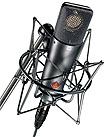|
Neumann TLM
193 Studio Microphone |
|

Product Code: TLM193


|
The TLM 193* is a
large diaphragm microphone with a cardioid polar pattern. With this microphone
Neumann continues its long tradition, and is offering high end technology at an
affordable price for musicians and the home recording studio.
The microphone uses a transformerless circuit, featuring extremely low self
noise and large dynamic range.
The polar response is very linear over a wide incidence angle. Thus, even
signals coming from the side are reproduced faithfully and without coloration.
The exposed surface of the microphone capsule is at ground potential, making it
immune to typical interference and contamination. The microphone is supplied
with a swivel mount.
Applications
The TLM 193 is a microphone with cardioid characteristic for professional
recording and live applications. It is the ideal microphone for professional
productions, for musicians and project studios.
Polar pattern
The TLM 193 has a large diaphragm capsule with cardioid characteristic.
Acoustic features
The TLM 193 is addressed from the front, marked with the Neumann logo. The large
diaphragm capsule inside the headgrille has a very smooth frequency response for
all polar patterns over a wide acceptance angle. The curves are flat and
parallel to the 0� frequency curve up to 10 kHz within a pickup angle of � 100�.
The TLM 193 differs from omnidirectional pressure transducers, where, due to
physical reasons, the diffuse-field and free-field responses never agree. This
microphone has a very even diffuse-field response for all polar patterns. This
is important in a reverberant environment, as more reflections arrive at the
microphone from different directions.
The acoustic information is not affected in its tonal quality when recorded by
the microphone. This characteristic is achieved without resorting to corrective
resonance effects. Therefore, the microphone maintains an excellent impulse
response reproducing all transient phenomena of music and speech without
coloration.
Electrical features
The letters TLM stand for "transformerless microphone". With TLM technology the
usual output transformer is replaced by an electronic circuit.
As with traditional transformers, it ensures good common mode rejection, and
prevents RF interference, that may influence the balanced audio signal.
Compared to other microphones the self noise level of the TLM 193 is
considerably reduced. As it is capable of handling sound pressure levels up to
140 dB without distortion, the TLM 193 provides a dynamic range of 130 dB
(A-weighted).
Operational safety
All exposed surfaces of the microphone capsule, including the diaphragms, are at
ground potential. This technology makes them highly immune to electrical and
atmospheric interference and contamination through microscopic dust particles.
The capsule is elastically mounted to avoid any structure borne noise that could
interfere with its operation.
The frequency response of the TLM 193 amplifier is linear down to 20 Hz. Even
very low bass signals are reproduced without coloration.
This implies that the microphone becomes more sensitive to subsonic frequencies,
from structure borne noise or pop and wind noise.
To avoid any LF interference, we recommend to use the EA 1 elastic suspension,
the PS 15 pop screen, or the WS 89 windscreen. |
� Large
diaphragm cardioid microphone
� Pressure-gradient transducer
� Transformerless circuitry
� Extremely low noise: 10 dB (A)
� Includes swivel mount
� The "plug and play" microphone for professional studios, musicians and
homerecording applications
� High-quality professional equipment for mid-size budgets |
| Acoustical operating
principle |
Pressure gradient transducer |
| Directional pattern |
Cardioid |
| Frequency range |
20 Hz ... 20 kHz |
| Sensitivity at 1 kHz into 1
kohm |
18 mV/Pa |
| Rated impedance |
50 ohms |
| Rated load impedance |
1 kohms |
| Equivalent noise level, CCIR |
21 dB |
| Equivalent noise level,
A-weighted |
10 dB-A |
| Signal-to-noise ratio, CCIR (rel. 94 dB
SPL) |
73 dB |
| Signal-to-noise ratio, A-weighted (rel. 94
dB SPL) |
84 dB |
|
Maximum SPL for THD
0.5% |
140 dB |
| Maximum output voltage |
13 dBu |
| Dynamic range of the microphone amplifier
(A-weighted) |
130 dB |
| Supply voltage (P48, IEC
61938) |
48 V ± 4 V |
| Current consumption (P48, IEC
61938) |
3 mA |
| Matching connector |
XLR3F |
| Weight |
480 g |
| Diameter |
49 mm |
| Length |
175 mm |
|
|
|
|
|
|
| |
|
|